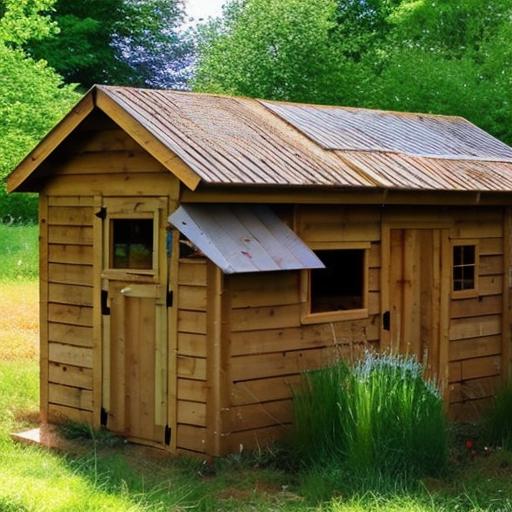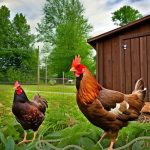Converting your shed into a chicken coop can be a rewarding and practical decision. There are numerous benefits to raising chickens, including having a cost-effective and sustainable food source, as well as the opportunity for a fun and educational experience for the whole family.
Raising chickens can be a cost-effective way to have a constant supply of fresh eggs. By converting your shed into a chicken coop, you can save money on store-bought eggs and have the satisfaction of knowing exactly where your food is coming from. Additionally, chickens can also provide meat if desired.
Furthermore, raising chickens can be a sustainable food source. Chickens are efficient converters of kitchen scraps and garden waste into high-quality fertilizer. They also help control pests in the garden by eating insects and other small creatures. By raising chickens, you can reduce your waste and contribute to a more sustainable lifestyle.
Raising chickens can also be a fun and educational experience for the whole family. Children can learn about responsibility, animal care, and where their food comes from. They can participate in feeding, cleaning, and collecting eggs, fostering a sense of connection to nature and the food they eat.
Assessing Your Shed: Is it Suitable for a Chicken Coop?
Before converting your shed into a chicken coop, it is important to assess whether it is suitable for this purpose. There are several factors to consider, including size and space requirements, structural integrity, and accessibility and location.
Firstly, consider the size and space requirements for your chicken coop. Chickens need enough space to move around comfortably and engage in natural behaviors such as scratching and dust bathing. The general rule of thumb is to provide at least 4 square feet of space per chicken in the coop, and 10 square feet per chicken in the outdoor run.
Secondly, assess the structural integrity of your shed. Make sure that the shed is sturdy and in good condition, as it will need to withstand the elements and the weight of the chickens. Check for any signs of damage or weakness, such as rotting wood or holes in the walls or roof. It is important to repair any issues before converting the shed into a chicken coop.
Thirdly, consider the accessibility and location of your shed. The coop should be easily accessible for cleaning, feeding, and collecting eggs. It should also be located in an area that provides shade and protection from extreme weather conditions. Consider the proximity to your house, as well as any noise or odor concerns.
Planning Your Chicken Coop Layout: Key Considerations
When planning the layout of your chicken coop, there are several key considerations to keep in mind. These include designing a functional and efficient layout, incorporating nesting boxes, perches, and feeding areas, and maximizing natural light and ventilation.
Firstly, it is important to design a functional and efficient layout for your chicken coop. Consider the flow of movement for both you and the chickens. Ensure that there is enough space for you to move around comfortably while performing tasks such as cleaning or collecting eggs. Also, consider the placement of doors and windows for easy access and ventilation.
Secondly, incorporate nesting boxes, perches, and feeding areas into your chicken coop design. Nesting boxes provide a comfortable and private space for hens to lay their eggs. Perches allow chickens to roost at night, which is a natural behavior for them. Feeding areas should be easily accessible and protected from pests.
Lastly, maximize natural light and ventilation in your chicken coop. Natural light is important for the health and well-being of chickens. It helps regulate their internal clocks and promotes egg production. Ensure that there are windows or skylights in the coop to allow natural light to enter. Ventilation is also crucial to prevent moisture buildup and maintain good air quality. Consider installing vents or windows that can be opened and closed as needed.
Choosing the Right Flooring for Your Coop
Choosing the right flooring for your chicken coop is essential for maintaining a clean and healthy environment. There are several options for flooring materials, each with their own pros and cons.
One option is to use bare earth as the flooring material. This is the most natural option and allows chickens to engage in natural behaviors such as scratching and dust bathing. However, it can be difficult to keep clean and may become muddy or dusty depending on the weather conditions.
Another option is to use concrete as the flooring material. Concrete is easy to clean and provides a solid surface that is resistant to pests. However, it can be hard on the chickens’ feet and may require additional bedding for comfort.
A third option is to use a combination of concrete and a deep litter system. This involves placing a layer of wood shavings or straw on top of the concrete floor and regularly adding fresh bedding material. The deep litter system provides insulation, absorbs moisture, and helps control odors. However, it requires regular maintenance to prevent the buildup of ammonia and pests.
Regardless of the flooring material you choose, it is important to regularly clean and maintain the coop to ensure a healthy environment for your chickens. Remove any soiled bedding or waste, and regularly disinfect the coop to prevent the spread of disease.
Insulating Your Shed: Keeping Your Chickens Warm in Winter
Insulating your shed is important for keeping your chickens warm during the winter months. Proper insulation helps regulate the temperature inside the coop and prevents drafts.
Insulation works by trapping air in small pockets, creating a barrier between the inside and outside temperatures. This helps maintain a more stable temperature inside the coop, keeping it warmer in winter and cooler in summer.
There are several types of insulation materials that can be used in a chicken coop. Common options include fiberglass batts, foam boards, and reflective insulation. Fiberglass batts are easy to install and provide good thermal insulation. Foam boards are lightweight and provide excellent insulation. Reflective insulation is a radiant barrier that reflects heat away from the coop in summer and retains heat in winter.
When installing insulation, it is important to follow proper installation techniques to ensure maximum effectiveness. Seal any gaps or cracks in the walls or roof before installing insulation to prevent drafts. Use appropriate safety precautions when handling insulation materials, such as wearing gloves and a mask.
Ventilation: Essential for Healthy Chickens
Proper ventilation is essential for maintaining a healthy environment for your chickens. Fresh air circulation helps remove moisture, odors, and harmful gases from the coop, preventing respiratory issues and other health problems.
Good ventilation also helps regulate the temperature inside the coop, preventing overheating in summer and condensation buildup in winter. It helps remove excess heat and humidity, creating a more comfortable environment for the chickens.
When designing a ventilation system for your chicken coop, consider the size of the coop and the number of chickens. The general rule of thumb is to provide at least 1 square foot of ventilation per 10 square feet of floor space. This can be achieved through windows, vents, or openings in the walls or roof.
It is important to prevent drafts and moisture buildup in the coop. Drafts can cause respiratory issues in chickens, while excess moisture can lead to mold growth and other health problems. Install vents or windows that can be opened and closed as needed to control airflow. Use screens or mesh to prevent pests from entering the coop.
Regularly inspect and clean the ventilation system to ensure it is functioning properly. Remove any debris or obstructions that may block airflow. Monitor the temperature and humidity levels inside the coop to ensure they are within a healthy range for your chickens.
Lighting: How Much Light Do Your Chickens Need?
Lighting plays an important role in the health and well-being of chickens, as well as their egg production. Understanding the role of light and providing adequate lighting in the coop is essential for the success of your chicken-raising venture.
Chickens require a certain amount of light each day to maintain their internal clocks and regulate their reproductive cycles. The amount of light needed depends on the breed and age of the chickens, as well as the desired egg production.
In general, chickens need about 14-16 hours of light per day to maintain optimal health and egg production. This can be achieved through a combination of natural and artificial lighting. Natural light can be provided through windows or skylights in the coop. Artificial lighting can be used to supplement natural light during the shorter days of winter.
When choosing artificial lighting for your chicken coop, it is important to choose the right type of light bulbs. Incandescent bulbs are not recommended, as they produce a lot of heat and can be a fire hazard. LED or fluorescent bulbs are more energy-efficient and produce less heat. Choose bulbs with a color temperature of around 5000-6500 Kelvin, which mimics natural daylight.
It is important to provide a consistent lighting schedule for your chickens. Use timers to ensure that the lights turn on and off at the same time each day. Gradually adjust the lighting schedule when transitioning between seasons to mimic natural daylight changes.
Nesting Boxes and Perches: Creating a Comfortable Home for Your Chickens
Creating comfortable nesting boxes and perches is essential for providing a cozy home for your chickens. Nesting boxes provide a private and comfortable space for hens to lay their eggs, while perches allow chickens to roost at night.
When designing and building nesting boxes, consider the size and materials. The size of the nesting boxes should be large enough for hens to comfortably enter and exit, as well as turn around and nest. A general guideline is to provide one nesting box for every 4-5 hens. The boxes should be lined with soft bedding material, such as straw or wood shavings, to provide a comfortable and clean surface for the eggs.
The materials used for nesting boxes should be durable and easy to clean. Wood is a common choice, as it is sturdy and provides good insulation. Avoid using materials that are difficult to clean or may harbor pests or bacteria.
Perches should be provided for chickens to roost at night, as it is a natural behavior for them. Perches should be placed at a height of about 2-3 feet off the ground and provide enough space for all the chickens to roost comfortably. The perches should be made of smooth and sturdy materials, such as wooden dowels or PVC pipes, to prevent foot injuries.
Regularly clean and maintain the nesting boxes and perches to ensure a healthy environment for your chickens. Remove any soiled bedding from the nesting boxes and replace it with fresh material. Clean the perches regularly to remove any droppings or debris.
Feeding and Watering: Setting Up a Convenient System
Setting up a convenient feeding and watering system is essential for the health and well-being of your chickens. Choosing the right feed and water containers, providing easy access for chickens, and preventing spills and contamination are important considerations.
When choosing feed containers, consider the size and material. The containers should be large enough to hold an adequate amount of feed for your chickens, but not so large that it becomes difficult to clean or attracts pests. Plastic or metal containers are commonly used, as they are durable and easy to clean.
Water containers should also be chosen with care. Chickens require a constant supply of fresh water, so it is important to choose containers that can hold enough water for your flock. Consider using waterers with nipples or cups that prevent spillage and contamination. Regularly clean and refill the water containers to ensure a clean and healthy water supply.
Provide easy access for chickens to the feed and water containers. Place them at a height that is comfortable for the chickens to reach, but not so low that they become easily soiled or contaminated. Consider using raised platforms or hanging feeders and waterers to keep them off the ground and prevent pests from accessing them.
Prevent spills and contamination by regularly cleaning the feed and water containers. Remove any spilled feed or debris from the feeding area to prevent pests and mold growth. Clean the water containers regularly to remove any algae or bacteria buildup.
Fencing and Security: Keeping Your Chickens Safe from Predators
Keeping your chickens safe from predators is essential for their well-being. Fencing is an important component of a secure chicken enclosure, as it helps keep predators out and chickens in.
When choosing fencing materials, consider the type of predators in your area. Common predators include raccoons, foxes, coyotes, dogs, and birds of prey. Choose fencing materials that are sturdy and can withstand attempts by predators to dig under or climb over.
Wire mesh or hardware cloth with small openings is commonly used for chicken enclosures, as it provides good protection against most predators. The mesh should be buried at least 12 inches into the ground to prevent predators from digging under. It should also be tall enough to prevent predators from jumping over.
Consider adding additional security measures to your chicken enclosure, such as a roof or netting to protect against birds of prey. Install locks or latches on doors and windows to prevent unauthorized access. Regularly inspect the fencing for any signs of damage or weakness, and repair as needed.
In addition to fencing, consider other security measures such as motion-activated lights or alarms to deter predators. Keep the area around the chicken coop clear of tall grass or brush that may provide hiding places for predators. Lock up feed and water containers at night to prevent attracting pests.
Enjoying the Rewards of Your Cozy Chicken Home
Converting your shed into a chicken coop can be a rewarding and fulfilling experience. By providing a comfortable and secure home for your chickens, you can enjoy the benefits of fresh eggs, a sustainable food source, and a fun and educational activity for the whole family.
A well-designed and maintained chicken coop provides a safe and healthy environment for your chickens. It allows them to engage in natural behaviors, such as scratching, dust bathing, and roosting. It also provides protection from predators and the elements.
Caring for your chickens involves regular maintenance and attention to their needs. This includes providing a balanced diet, clean water, and a clean living environment. Regularly inspect the coop for any signs of damage or health issues, and address them promptly.
Enjoy the rewards of your cozy chicken home by collecting fresh eggs daily and enjoying the satisfaction of knowing exactly where your food is coming from. Involve the whole family in caring for the chickens, fostering a sense of responsibility and connection to nature.
By converting your shed into a chicken coop, you can create a sustainable lifestyle that provides fresh food, educational opportunities, and a sense of fulfillment. Embrace the joys of raising chickens and enjoy the many benefits that come with it.
Meet Walter, the feathered-friend fanatic of Florida! Nestled in the sunshine state, Walter struts through life with his feathered companions, clucking his way to happiness. With a coop that’s fancier than a five-star hotel, he’s the Don Juan of the chicken world. When he’s not teaching his hens to do the cha-cha, you’ll find him in a heated debate with his prized rooster, Sir Clucks-a-Lot. Walter’s poultry passion is no yolk; he’s the sunny-side-up guy you never knew you needed in your flock of friends!







